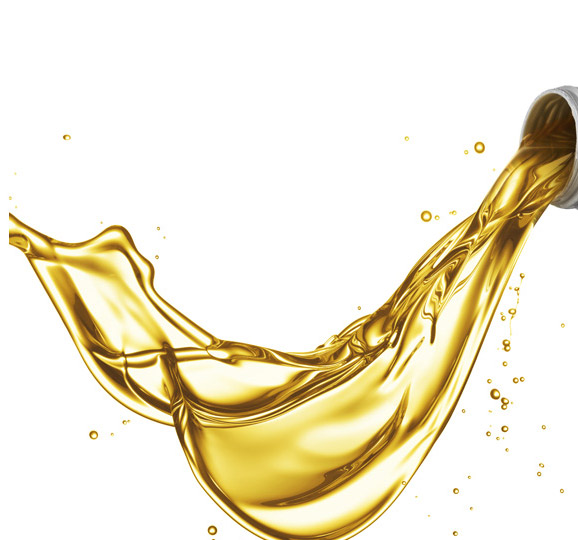What causes black motor oil? And when your oil darkens does it mean it’s time to change it? Well, there are a couple of factors that can cause the former. Let’s dig in.
Factors That Cause Black Motor Oil
Heat cycles naturally darken motor oil.
During your drive to work in the morning, your engine reaches normal operating temperature (typically 195°F–220°F [90°C–104°C]), heating the motor oil. Then the oil cools while your car sits in the parking lot.
During lunch, the oil again is exposed to heat during your drive to the bank or home center. The process repeats on the way home. And the next day. And the next.
These “heat cycles” continually expose the oil to high heat, which naturally darkens motor oil.
Some additives in motor oil are more susceptible to darkening in the presence of heat than others. In addition, normal oxidation can darken oil, too. Oxidation occurs when oxygen molecules interact with oil molecules and cause chemical breakdown, just like how oxygen causes a cut apple to brown or iron to rust. High heat accelerates oxidation.
Deposits Can Lead to Black Motor Oil
The motor oil contacts nearly everything inside the engine during operation, including deposits that may have formed on engine parts. Since carbon deposits are usually black in color, it won’t take long for the oil to turn black if there are deposits inside the engine.
Soot Causes Oil to Turn Black
While heat cycles cause oil to darken, soot causes oil to turn black. Most people associate soot with diesel engines, but gasoline engines can produce soot as well, particularly modern gasoline-direct-injection engines.
Soot is a byproduct of incomplete combustion. Since soot particles are less than one micron in size, they typically don’t cause engine wear. For comparison, a human hair is roughly 70 microns in diameter.

If soot particles agglomerate into larger wear-causing contaminants, the oil filter will catch them. Sometimes people who use bypass filtration systems, which can filter contaminants down to two microns, express surprise that the motor oil is still black.
Soot, however, can still elude filtration down to two microns. Any finer filtration and the filter could catch dissolved additives in the motor oil.
Oil Myth: Oil Color Indicates When it’s Time for an Oil Change
It’s common to assume that black motor oil has worn out or become too saturated with contaminants to protect your engine and requires changing. Not necessarily. As we saw, discoloration is a natural byproduct of heat and soot particles, which are too small to wear out your engine.
Oil darkness is not an indication of the condition of the oil itself. The detergents and dispersants in the oil are what causes it to darken as it is doing its job in cleaning the engine and carrying particulates to the oil filter.
The only surefire way to determine if the oil has reached the end of its service life is to perform oil analysis. Chemically analyzing an oil sample reveals the condition of the oil, the presence of contaminants, fuel dilution and so on. Several companies offer oil analysis services, including Oil Analyzers INC.
Absent oil analysis, it’s best to follow the oil-change recommendation given in your vehicle owner’s manual or by the motor oil manufacturer. The recommended service intervals for AMSOIL products, for example, are based on thousands of data points spanning years of use.
It’s best to trust the data, not your eye, in this case. Otherwise, changing the oil could amount to throwing away good oil.
Why is My Oil Still Dark in Color After Installing an AMSOIL Bypass Filter?
If your diesel engine is equipped with exhaust gas recirculation (EGR), the soot in your exhaust is reintroduced into the engine’s intake and soot particles are constantly being put back into your combustion chamber and making their way into your oil. The average full-flow oil filter can efficiently remove wear particles 20 microns in size and larger, and while an AMSOIL Bypass Filter can efficiently remove particles down to 2 microns, it cannot capture all the soot particles smaller than 2 microns.
These small soot particles have a coloring effect that can turn your oil dark. The good news is AMSOIL synthetic diesel oils have high dispersant additives that effectively keep these small soot contaminants in suspension, preventing them from agglomerating and forming larger, wear-causing contaminants.






I’ve always been told that oil never wears out and that the additives in the oil do. My dad was an engine builder and I’ve been a mechanic for about 50 years. Since there is no real conclusive way to know when the additives have reached their limit what is your best advice about changing oil in an air-cooled, or water cooled motorcycle engine?
I have been an Amsoil user since 1993. I currently have 85000 miles on my 2003 Kawasaki Nomad 1500.
Hi Dan,
Used oil analysis can identify additive levels, but rarely will the oil be condemned by additive level alone. The oil’s Total Base Number, which is a measure of its ability to neutralize acids, is a better indicator of oil life.
That said, the best way to determine when to change oil in a motorcycle (or car, for that matter) is to perform oil analysis. For what it’s worth, Oil Analyzers INC. is one lab that offers oil analysis services.
Thanks for reading.
I am approaching the 300,000 mile mark on my 06 Focus with almost no oil usage in the 10,000 mile change intervals ! The day I bought this car new I switched to the XL series oil and have used it since; if that isn’t a testimony on the quality of Amsoil nothing is; Thanks and here”s to a lifelong customer relationship !!!!
Hi Tim,
Thanks for the story; it’s always satisfying to hear from people who’ve had great experiences with our products.
Thanks for reading.
I’m with you Tim my name is VINCE and I’ve been using AMSOIL ever since they almost came out I put it in my 79 vehicles in all my newer vehicles my Dodge truck from 99 Till today and it still running strong I bought a new vehicle that had 3000 miles on it with the manufactured oil in there and when I drain that out and I put AMSOIL in it literally had cleaned the engine I no longer smell that oil in there anymore I’ve been using AMSOIL forever it goes in everything that I drive and it will continue for the rest of my life AMSOIL you are the king of oil’s again this is Vince and no I am not even a dealer I’m just a satisfied customer thank you again AMSOIL VINCE
Hi Vince,
We always love to hear from happy customers. Thanks for your loyalty.
Thanks,
John
I love Amsoil and use the XL series in both of my vehicles. (2006 Acura MDX and 2003 Chevy Impala)
I also use the Amsoil transmission fluid as well.
I am very happy that we at Greenlight Auto Care in San Diego, CA. are authorized distributors and carry the OE, XL and Signature series oils and the OE transmission fluids.
I personally can tell a difference on how well the engines run ever since I changed over from Mobil1 synthetic.
I find that statement false
I’ve used and also was a dealer for amsoil, but due to the cost of renewing my dealership and the hassle of get amsoil I’ve switched to 2nd best and easy to purchase mobile 1,I love amsoil but not the hassle to purchasing it
Dang, Jackie, you’re killing me!
You can always register as a Preferred Customer. You get AMSOIL products up to 25 percent off of retail. And we ship right to your door, usually in three days or less.
My ford f150 runs un propane since day one.
The oil changes to a reddish color, not blacķ between intervals. Can you tell me why?
Hi Martin,
This is quite common with our oils. There is often a slight color change due to the anti-oxidants used in our oils, either to a darker amber color or slight reddish tint. Since you’re using propane, the oil is probably cleaner than oil used in a gasoline engine, so the color change is more evident.
The color change is not detrimental – it just shows the anti-oxidants in the oil are doing their job.
Thanks for reading.
my friend in highschool worked for a propane company. had a ford truck converted. runs 100 times cleaner than a gas engine. he shows us the oil after 10k miles and it was still clear. didnt see a redish color unless you mean redish brown. kudos on you cleaner burning vehicle.
Could also be the oil dispersing (dissolving) some varnish on engine components. Could be that It´s cleaning up your engine.
Agreed! We bought an 06 Honda Pilot with 69 thousand miles, since then we have used the 5w-30 signature Amsoil. We have used that vehicle for many family vacations, it’s also my wife’s work vehicle. Today the odometer is at 275 thousand. I will continue using Amsoil for all of our future vehicles.
Thanks.
I recently changed to AMSOIL in my 2015 Dodge Journey. I did my first oil change last week at 10k miles. I did notice that the oil was still the same color as the new oil going in. That was impressive. Then I looked at the cartridge filter and saw that it was blacker than ever before. I feel like the filter is doing it’s job but may not be suited to a much longer interval than with the 5,000 mile factory change. Is there a better option?
Hi,
What kind of filter are you using? AMSOIL makes an oil filter for your Journey that’s recommended for up to 15,000 miles. If you’re not using it, I recommend giving that filter a try with your next oil change.
Thanks,
John
Just pickup a 04 land cruiser with 206 thousand miles previous owner used Toyota oil, should I say with Toyota oil or is it to late to switch to Amsoil?
Hi Kevin,
It’s perfectly save to switch to AMSOIL synthetic motor oil, regardless of mileage.
Thanks,
John
I would stick with the same oil now. Different manufacturers use different detergents and additives, therefore could be counterproductive to your seals that are a custom to the Toyota oil
It’s perfectly fine to switch to AMSOIL. AMSOIL is designed and engineered to keep seals pliable, if you develop any leaks, it’s a mechanical problem, not an oil problem. I have customers that switch all the time, regular maintenance is something that tends to be lost on folks these days. If you have a high mileage vehicle, just keep an eye on it and change a seal if it needs it. Just switching to Amsoil will not create leaks, and is not a mechanic in a bottle to take place of your routine of checking fluids, etc.
Hey great tips on engine oil. Thanks for sharing this information up here. It is true that most people believe that the color of the oil indicates whether it is time to replace it or not. Glad you clarified this confusion here.
Good to know ! I always thought that dark color had something to do with tired oil, I mean really dark! I have changed a lot of oil in my 80 years and still remember my uncles ford wagon with 202 v8 , I changed it for him cause he was broke and had not changed for over 10000 mile. How this was 1957, the oil was actually sort of boiling with movement of surface tension! The engine was in bad shape. The oil was more than just very dark! My first car ,1947 ford had oil in the pan that was so hard it stopped the crank from turning when I tried to push start. Wondering how oil could do that? Have been a Amsoil dealer for some time and have found most people don’t keep their cars long enough to care, they buy synthetic,but the cheapest they can find or the dealership free oil change with bulk junk. Only have a few who are sensitive enough to appreciate the difference.
I use Amsoil in everything I have.
But I don’t believe in leaving oil in a motor for extended intervals.
Also keep in mind that MFGs today know that most vehicles rust out before ever wearing out the motor.
Most not all……..
They have all gone to an extended oil change interval to give the impression of low cost of ownership.
This lower cost of ownership comes at the expense of engine wear.
One that really stands out is the Ford V8 3 valve. Seen two of these a part . One was maintained by the dealer at the recommended oil change intervals and the other by the owner.
The one with the oil changed at the MFGs recommended change intervals needed a cam chain. The other didn’t .
Also the MFGs maintained motor was dark and dirty inside. While the other owner maintained motor was clean with very little wear.
GM changed there programming for the oil change, or oil life remaining system on some of there cars because it was found that extended oil change intervals was causing premature cam chain failures.
What does this tell you? Tells me a lot about Not following MFGs extended oil change intervals. This was a GM recall…… abuse they got it WRONG……..
Don’t forget once oil gets old and looses its additives pkg it looses its ability to protect the motor.
Admittedly if your using Amsoil and change the oil at 3k then you are wasting your money and dumping oil that will easily go twice that distance.
But
I can tell you from experience that not all oil (even the big brand names) are high quality oil.
I was experiencing oil usage in my wife’s Suzuki Grand Vitara. Down a quart after 3k. I was using what I thought and many others on the internet said was the best full synthetic oil out there. I also noticed that the aluminum inside the motor had turned very dark. As if the oil was causing the aluminum to darken .
Same look as the Ford maintained V8 mentioned above.
Thought I would try Amsoil just for the hell of it . The oil usage stopped. I noticed when I looked into the motor from the oil fill cap the burnt look was getting lighter. The Amsoil was cleaning the residue from the oil I had been using.
I was very P.O.ed that the expense highly rated major MFGs oil was actually a poor quality oil.
This was all the proof I needed that Amsoil is the way to go.
Rob
Rob,
To substantiate your statement, we had an Explorer with the 4.6l 3v. These motors are know to need time chains and cam Phaser between 80-120k miles. We used M1 for the first year and switched to AMSOIL Signature Series using once a year 14-17 oil change intervals. We donated the vehicle to our son last fall with 200k miles. The engine has never been touched. About 220k miles now and still running strong.
It’s interesting to learn that soot 70 times smaller than human hair so finer oil filters should be used to prevent the blackening of the engine oil. All my life, I always thought that the black oil coming from my tractor is normal and that it’s not a sign of anything bad. From now on, I’ll make sure to get soot out of my engine so that it can work more efficiently.
Great comments.
The reason I was interested was that I used semi synthetic oil in my petrol jet washer engine and the pump unit. The oil turned black. Your comments explained why. I didn’t know that carbon would pass the rings into the sump. But still can’t see why the oil in the pump would turn black. It was a cheaper brand oil. Also I was told that if using semi synthetic oil it will accept being topped up with full synthetic or non synthetic. But full synthetic does not like non synthetic oils mixed with it.
Hi Allen,
Yes, you can mix synthetic and semi-synthetic oil safely. But mixing the two will only reduce the performance of the synthetic oil, so we don’t recommend it if you can help it.
Thanks,
John
Hello,
Thanks for a very informative article. I recently purchased a 2020 Toyota Prius Prime (PHEV, Plug-in Hybrid Electric Vehicle) that calls for a 10K-miles/12-month OCI for “normal” use. Toyota recommends burning a minimum of 5.3 gallons over a 12-month period, which to me equates to running the engine for 7 miles every Monday. There is concern that the engine oil could degrade from oxidation, moisture, etc., from such infrequent and short use of the engine. A couple of questions:
1. What kinds of degradation an engine oil in this case is exposed to?
2. Have Amsoil oils been tested to be able to withstand degradation from such an infrequent and short use for a 12-month OCI for PHEVs?
3. If not, what’s your recommendation for an OCI in the PHEV scenario? Should the filter be changed more frequently or can it be replaced less frequently?
4. Toyota calls for a 0W-16 API SN/RC multigrade engine oil. Is the Amsoil Signature series 0W-16, a API SN/RC multigrade engine oil?
5. If not a API SN/RC multigrade engine oil, could using the Amsoil Signature series 0W-16 in the Prius Prime void the warranty?
Thanks in advance.
Hi,
I’ll tackle your questions one by one.
1. What kinds of degradation an engine oil in this case is exposed to? Oxidation, primarily. Oxygen molecules attack the oil molecules and degrade them, similar to oxygen causing iron to rust or an apple to turn brown. You can read more about it here.
2. Have AMSOIL oils been tested to be able to withstand degradation from such an infrequent and short use for a 12-month OCI for PHEVs? In PHEVs specifically, no. But they’ve been shown time and again via oil analysis to last up to one year, even during infrequent use. Whether the engine is a PHEV or a supercharged V-8 doesn’t matter to the question of oxidation degrading oil over time; oxidation will degrade the oil in any engine.
3. If not, what’s your recommendation for an OCI in the PHEV scenario? Should the filter be changed more frequently or can it be replaced less frequently? Simply follow the manufacturer’s recommendations. There’s no need to change the filter more frequently.
4. Toyota calls for a 0W-16 API SN/RC multigrade engine oil. Is the AMSOIL Signature series 0W-16, a API SN/RC multigrade engine oil? Signature Series isn’t available in 0W-16, but AMSOIL OE Synthetic Motor Oil is, and it is rated for API SP (Resource Conserving), which is backward compatible to API SN.
5. If not a API SN/RC multigrade engine oil, could using the AMSOIL Signature series 0W-16 in the Prius Prime void the warranty? No, using AMSOIL OE 0W-16 Synthetic Motor Oil won’t void your factory warranty. U.S. law protects your right to use whichever brand of oil you choose.
Hi John:
On june 26th, I took my Jeep to my local Jeep dealer(Carlsbad, CA) for an oil change before driving to Montana. I’ve put on about 3500 miles since then. After being very uneasy for a few weeks, I recently changed my oil again because it seemed abnormally dark. My question-Can oil color change that much in such a short time ?
It was conventional oil(I think it’s called bulk at the dealer)I’ll admit-It was a long drive and some of the roads were dusty. But, I’m just a little questionable if the service was done.
Nice info you supply.
Thanks for your input,
Louie
Louie
Hi Louis,
While a diesel engine can rapidly change the color of the oil with soot, a gasoline engine can also change the color of the oil through temperature changes, especially a conventional oil. Each cycle of heating can darken the oil just a bit more until it looks nearly black.
As long as the oil does not smell burnt or have a gritty feel when rubbed between your fingers, the color is not a good indicator of oil condition.
Thanks,
John
Thank you for pointing out that black oil can still be usable depending on the conditions of your drive. I’ve been very worried about my car’s engine lately, as I’ve noticed that it’s been leaking out of my car very often and ended up being black-ish in color. While I want to be safe about it, I still don’t want to waste any uneccessary money on it, so I’ll consult an oil changing place first and see what they have to say.
That’s really nice post. I appreciate your skills. Thanks for sharing.
Hi John,
Please tell if there is an expiry date and shelf life for motor oils while unused, kept in original packing.
It is a myth that if motor oil has not got any application with the engine for so many years, it is as good as blended recently.
Does the quality of an old blended oil is affected with the passage of time or not?
Thanks for your reply.
Hi Hasan,
I can’t speak for other oil companies, but the shelf life of AMSOIL synthetic motor oil when stored properly is five years. Get the details in this blog post.
Thanks,
John
I have my dealership do all recommended maintenance on my 2017 Ram 1500 Ecodiesel at the intervals the manufacturer stipulates. I’ve had heated arguments with them in the past that by the time I get home after an oil change (about 12 miles) the oil is already black. I physically watch them change the oil and filter! Is this normal to turn black so quickly?
Hi Richard,
I’ve never heard of new oil turning black that quickly. Twelve miles isn’t enough time to allow heat cycling to discolor the oil that dramatically. Next time, try pulling an oil sample after you arrive home and sending it for oil analysis. That is the best way to find out precisely what, if anything, is happening to the oil.
Thanks,
John
Every Diesel semi I’ve drive over the 24 years of my career, the oil was just as black after an oil change as it was before it was done.